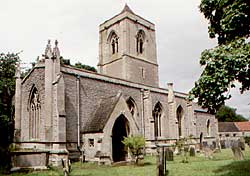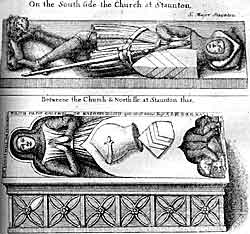
St Mary's church, Staunton (A. Nicholson, 2002).
In the year 1853, at which time the Rev. Charles Wing was rector of the parish, the church was re-built almost entirely. Nothing of the old chancel now remains, and the roofing is new; but in the north wall and arcade of the nave we have examples of the old work restored on sound principles, and of new work rightly constructed on the older lines.
The original ground plan has been retained, and consists of a nave with south porch, a north aisle with east-end tower and a chancel. The architecture of the church belongs to the Decorated period, and the north doorway is a good example of the work of this period; both the ogee hood-moulding and elaborate finial being worthy of notice. Above this doorway there is a canopied niche which formerly contained an image of St. Mary the Virgin, the patron Saint of this church, and to the left of the ogee there is a memorial slate built into the exterior wall “to the memory of the Rev. John Mounsey, who was “curate of this parish fifty years, and died the 3rd day of May, 1827, aged 77 years.” At the restoration, this north wall seems to have remained largely untouched. It is decorated in the upper part with sculptured heads, grotesque, humorous and otherwise, and the buttresses are bevelled off so as to present a narrow face and have their gabled off-sets terminated with a fleur-de-lis. The tower has fortunately been left entirely in its original state, and is a very fine one of three stages, with good base-moulding and buttresses. The bell-stage has a well-moulded parapet and conical roof and a two-light transomed window on each face, and now contains five bells dated 1604, 1738, 1827, 1827, 1742 (treble) respectively. The church terriers of 1809 and 1817, both speak of four bells only, and it appears that the two 1827 bells were cast at Gainsborough in place of one hell at Staunton that had sustained a crack, and two bells from Kilvington church. A north doorway has been cut through the floor stage of the tower, and the arch on the south side which originally opened into the nave at the north-east corner has been blocked up. Entering the church, we find an arcade of three bays in addition to which there is a small western arch apparently part of the original work. Where the stone has not been re-worked the arcade has a reddish tint that suggests its having been formerly coloured. The arches are lofty and elegant, and both the columns and moulded capitals are octagonal. Some of the oldest inhabitants can remember a raised vault, about four feet high, existing at the west-end of the nave, but this disappeared at the restoration of the church, if not earlier.

Staunton family monuments in the Choir of St Lawrence, Staunton church, published in Thoroton's History and Antiquities of Nottinghamshire (1677).
The aisle to the north of this arcade was originally known as the quire of St. Lawrence, and will be found so named as the resting place of Thomas and Anne Staunton, in Robert Cade’s “The Staunton’s Petygrewe,” given at length by Thoroton. Here have been placed a good number of the Staunton monuments, gathered from different parts of the church, one or two bearing the oldest black-letter inscriptions we possess. Beginning at the west end of the chapel and proceeding eastwards, we have the monuments now, in the following order:—(1) Mauger, who held Belvoir before the Conquest; (2) his son, Mauger; (3) Dame Joane, the wife of Geoffrey Staunton, and daughter of John of Lowdham; (4) William de Staunton, grandson of the first Mauger—this is a stone coffin; (5) illegible; (6) Cecilia, the mother of Dame Joane; (7) William de Staunton, son of Galfrid, and grandson of William—this also is a stone coffin; (8) Anthony Staunton and Sitha, his wife—this is a memorial slab built in the wall, and near the pulpit; (9) in the chancel, another to Robert Staunton, who built the porch at the Hall and died in 1582. The inscriptions on these tombs are given in Thoroton’s Nottinghamshire. The monument to the first Mauger was originally on the south side of the nave, and in Cade’s rhyming pedigree Dame Joane “Li’the in Sainet Laurence queare,” as well as Thomas Staunton and his wife Anne. The inscription on Dame Joane’s monument is an example of Norman French. A very interesting feature of the church is the rood-screen. It is sixteenth century work, and is a very good example. The rector, the Rev. F. J. Ross, has himself taken the trouble to remove the many coats of paint with which it was covered. It bears an interesting inscription, carved in black-letter type, which reads as follows, “[Pray] for the “saule of Mayster Simon Yates, bachelor in Law living in Newark, Parson of this Church and of Beckingham and “official of the Archdeaconry” [who?] “caused this Rood Lofte “and the Tabernacle of our Lady to be made in the yere of our “Lord 1519 on whose saul God have mercie.” The bowl of the font is a circular Norman one, closely resembling that at Screveton, of which font an illustration was given in the first volume of our Transactions. The bowl of the Staunton font has the same interlacing semi-circular arch-work, and has been placed on a modern stem. The base is probably earlier than the stem, and later than the Norman bowl.
There was formerly a chapel in the churchyard, belonging to the parish of Orston, the service thereof was a charge upon the parish of Orston, the Stauntons at one time, as lessees of the Dean and Chapter of Lincoln, paying some stipend for these ministrations. The chapel was built by Sir Geoffrey de Staunton, and was intended to provide for that part of Staunton which lies in the Hundred of Bingham, the tithes of which belonged, with the rest of the rectory of Orston, to the Church of Lincoln. At the present rectory house are to be seen a double set of Registers for “the Church parish of “Staunton,” and for “the Chapel side of Staunton;” separate sets of churchwardens were elected, and separate accounts kept. Mr. Allin, an old inhabitant of Staunton, and now well over eighty years old, remembers carrying the cushions from the Staunton pew in the church to the Staunton pew in the chapel when he was quite a small boy. The chapel was pulled down in the early years of last century.
